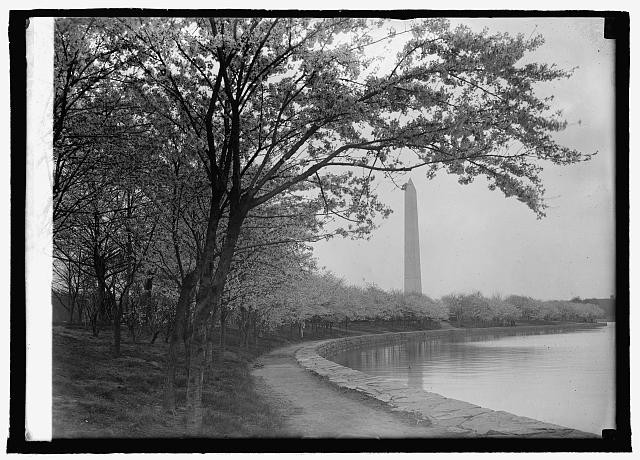Japanese Cherry Trees
Introduction
Text-to-speech Audio
Images
Cherry trees ca. 1920, with the Washington Monument in the background. Courtesy of the National Photo Company Collection, Library of Congress (public domain)

Visitors view the cherry trees in bloom along the Tidal Basin, with the Martin Luther King, Jr. Memorial in the background. Courtesy of the National Park Service (public domain)

Backstory and Context
Text-to-speech Audio
First Lady Helen Herron Taft traveled to the Philippines in 1901 and saw Lunete, a beautiful park space that inspired her to develop a cultivated landscape in Washington, DC a years later when her husband was president. While she worked with DC socialites on developing new park spaces, Japanese chemist Jokichi Takamine heard her plans to plant cherry trees and suggested acquiring them from Japan to strengthen ties between the two countries. This "landscape diplomacy" transformed the city.
Japan offered to donate 2000 cherry trees of several varieties, representing different regions of Japan. The first shipment of trees, arriving in Seattle in 1910, had to be burned after USDA officials discovered pests and disease during inspection. The second batch of over 3000 trees arrived in 1912 with a letter from the Mayoress of Tokyo, Yei Theodora Ozaki, wife of the city's mayor.
The first planting took place March 27, 1912. Helen Taft and Viscountess Iwa Chinda, wife of the Japanese ambassador, planted two Yoshino cherries (Prunus x yedoensis), the first of over 3700 cherry trees planted in the capital. Taft gave the VIscountess a bouquet of American Beauty roses at the event. The trees began to bloom four years later.
The city held its first Cherry Blossom Festival in 1935. Some trees were vandalized after the Japanese bombing of Pearl Harbor in 1941, but the landscape diplomacy continued after the end of World War II with the US giving budwood from the trees to the city of Tokyo to replenish the cherry grove of Adachi Ward. Fewer than 200 of the over 3000 original trees from the first plantings survive. Several times throughout the twentieth and twenty-first centuries, more trees have been planted by American and Japanese diplomats in commemoration of the original planting ceremony and as a symbol of international friendship.
Sources
--. “Original Cherry Trees,” Histories of the National Mall, accessed December 12, 2020, http://mallhistory.org/items/show/24.
Burton, J. Makali. A Symbol of International Friendship, Historical Marker Database. June 5th 2020. Accessed December 12th 2020. https://www.hmdb.org/m.asp?m=93423.
Fuchs, Tom. The 1912 Cherry Tree Plantings, Historical Marker Database. June 17th 2019. Accessed December 12th 2020. https://www.hmdb.org/m.asp?m=215.
Fuchs, Tom. The First Japanese Cherry Trees, HIstorical Marker Database. June t6th 2019. Accessed December 19th 2020. https://www.hmdb.org/m.asp?m=54912
National Park Service. History of the Cherry Trees, Cherry Blossom Festival. January 14th 2020. Accessed December 12th 2020. https://www.nps.gov/subjects/cherryblossom/history-of-the-cherry-trees.htm.
https://www.loc.gov/pictures/item/2016844782/
https://www.nps.gov/articles/new-beginnings-cherry-blossoms-helen-taft.htm
